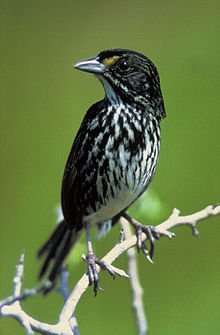Dusky seaside sparrow
| Dusky seaside sparrow | |
|---|---|
 |
|
| Scientific classification | |
| Kingdom: | Animalia |
| Phylum: | Chordata |
| Class: | Aves |
| Order: | Passeriformes |
| Family: | Emberizidae |
| Genus: | Ammodramus |
| Species: | A. maritimus |
| Subspecies: | A. m. nigrescens |
| Trinomial name | |
|
Ammodramus maritimus nigrescens (Ridgway, 1873) |
|
The dusky seaside sparrow, Ammodramus maritimus nigrescens, was a non-migratory subspecies of the seaside sparrow, found in Florida in the natural salt marshes of Merritt Island and along the St. Johns River. The last definite known individual died on June 17, 1987, and the subspecies was officially declared extinct in December 1990.
The dusky seaside sparrow was first categorized as a species in 1873, after its discovery on March 17, 1872 by Charles Johnson Maynard. Its dark coloration and distinct song are what separates it as a subspecies of other seaside sparrows. Found in the marshes of Florida's Atlantic Coast on Merrit Island and the upper St. Johns River, the dusky seaside sparrow was geologically isolated from other seaside sparrows (Hill 239). it was categorized as a subspecies in 1973. Even though the dusky's mitochondrial DNA is the same as the mitochondrial DNA of other seaside sparrow populations, DNA testing by itself does not demonstrate that its subspecies classification is undeserving (Hill 239). In 1981, only five dusky seaside sparrows remained, all being males. Conservation efforts were made by trying to breed the remaining duskies with Scott's seaside sparrows in order to create half dusky hybrid offspring. "Unfortunately, although the Fish and Wildlife Service initially supported the crossbreeding program, it withdrew its support due to Interior's hybrid policy" (Hill 239). Due to only the males being left, even though duskies could be crossbred with other seaside sparrows, there would never be another pure dusky seaside sparrow again.
Based on comparisons between mtDNA of the dusky seaside sparrow and its close relative, Scott's seaside sparrow, John Avise and William Nelson were able to estimate the last time that the dusky sparrow and the seaside sparrow came in contact. Since it has been established that the dusky sparrow had a very small inhabited locale, it was isolated from other sparrows for a very long time. Assuming that the mtDNA in sparrows evolves at the rate which is estimated for mammals and other birds (approximately 2-4% every million years), then the last time the dusky sparrow was in contact with Scott's seaside sparrow was approximately 250,000-500,000 years ago, giving plenty of time for the dusky sparrow to establish differences between other varieties of species, such as its unique plumage and call.[1]
...
Wikipedia

